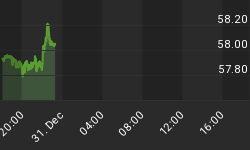If you own stocks, you want gold and economically-sensitive silver to perform well. Weakness in precious metals is reflective of diminished concerns about future inflation and increasing concerns about deflation. The Fed, via money-printing exercises such as quantitative easing (QE), is attempting to "inflate away" the large debt burdens plaguing governments around the globe. The Fed is also trying to hold off deflationary forces, which can morph into a negative economic feedback loop of falling asset prices. If gold and silver cannot muster a sustainable rally soon, it will tilt the economy and markets toward bearish/deflationary outcomes over the coming weeks and months.
Chart patterns in technical analysis are a way of monitoring human behavior. The patterns tend to produce fairly predictable results, but sometimes humans stray from the pattern. In recent months, potentially bearish patterns have surfaced for both gold and silver, which could be an ominous signal for stocks. The action in precious metals aligns with the concerning setups in the currency markets outlined on December 12.
As shown below, gold has traced out a head-and-shoulders topping pattern. The blue line is neckline of the pattern. A break of the neckline tends to foreshadow further downside. However, it is not uncommon for price to retest the neckline, which means the gold ETF (GLD) could move back toward the 161.50 to 164.00 range while staying within the confines of the potentially bearish set-up. A sustainable move above the neckline would greatly reduce the odds of the pattern holding true to form. If the pattern remains in place, GLD could logically fall toward 146.00 in the coming weeks, which would represent an additional loss of 7.8%.

In addition to the head-and-shoulders pattern appearing on the chart of the silver ETF (SLV), gold's cousin has traced out a series of lower highs (orange arrows) and lower lows (blue arrows). The lower highs and lower lows define a bearish downtrend. A retest of the upward sloping blue neckline could bring SLV back toward the neighborhood of 30.64 to 31.05. If SLV fails to retake the neckline, a decline toward 26.40 could be in the cards. A move to 26.40 would add 11.46% to the losses incurred in SLV since the late April peak.

We have been concerned about gold and silver for some time. We stopped out of SLV near 36.00 way back on May 10. SLV has dropped roughly 17% since May 10. We exited GLD on August 24 near 170.00. GLD has dropped roughly 7% since August 24.
The Fed and global central bankers remain bullish wild cards for precious metals and stocks. The Fed seems to be taking a wait-and-see approach on the next round of QE. If risk assets take another leg down, gold and silver could provide early clues relative to the market's expectations for more QE. As long as gold and silver remain weak, it is bearish for both risk assets and expectations for QE. Until conditions improve, we will continue to favor conservative assets, such as cash and the U.S. dollar (UUP). Given the generic statement for the Fed on Tuesday, we also have a small exposure to shorts (SH).
















